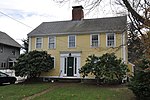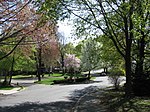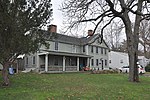Saint Joseph School (Wakefield, Massachusetts)
1925 establishments in MassachusettsEducational institutions established in 1925Gothic Revival architecture in MassachusettsNational Register of Historic Places in Wakefield, MassachusettsPrivate K–8 schools in Massachusetts ... and 4 more
Private middle schools in MassachusettsRoman Catholic Archdiocese of BostonSchool buildings on the National Register of Historic Places in MassachusettsWakefield, Massachusetts Registered Historic Place stubs

Saint Joseph School is a private, Catholic school located on Gould Street in Wakefield, Massachusetts. It serves students from preschool to 8th grade.The two-story Neo-Gothic Revival brick school building was designed by Maginnis & Walsh and was built in 1924. It was added to the National Register of Historic Places in 1989 as a locally rare example of Gothic Revival architecture. The parish for which it was built was established in 1850; the school began with a single grade and was gradually expanded to eight, taught by the Sisters of Saint Joseph.
Excerpt from the Wikipedia article Saint Joseph School (Wakefield, Massachusetts) (License: CC BY-SA 3.0, Authors, Images).Saint Joseph School (Wakefield, Massachusetts)
Gould Street,
Geographical coordinates (GPS) Address Nearby Places Show on map
Geographical coordinates (GPS)
| Latitude | Longitude |
|---|---|
| N 42.500555555556 ° | E -71.079166666667 ° |
Address
Gould Street 25
01880
Massachusetts, United States
Open on Google Maps










